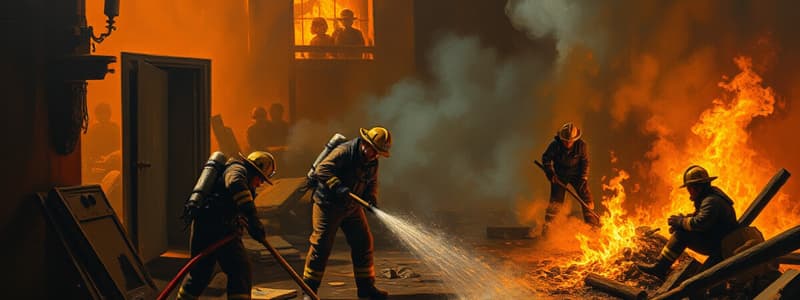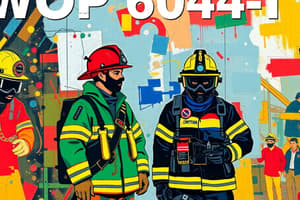Podcast
Questions and Answers
What is the primary objective of the mop up process in firefighting?
What is the primary objective of the mop up process in firefighting?
- To create barriers to limit fire spread
- To put out all fire embers or sparks (correct)
- To conduct reconnaissance of the fire-affected area
- To rebuild structures damaged by fire
When is mop up considered an independent part of firefighting?
When is mop up considered an independent part of firefighting?
- During the initial stages of fire control
- At the sighting of the first smoke or flames
- Once all line construction is completed and fire spread is stopped (correct)
- After the fire is completely extinguished
What should firefighters prioritize when starting mop up operations?
What should firefighters prioritize when starting mop up operations?
- Safety of the crew above all else
- Extinguishing all fires regardless of location
- Less threatening areas of the fire line
- Treat the most threatening situations first (correct)
Which method should be used to dispose of fuel that poses a fire risk after mop up?
Which method should be used to dispose of fuel that poses a fire risk after mop up?
How should firefighters handle large fires during mop up?
How should firefighters handle large fires during mop up?
What should be done with smoldering materials during mop up operations?
What should be done with smoldering materials during mop up operations?
What key factor should dictate water usage during mop up?
What key factor should dictate water usage during mop up?
In terms of monitoring after mop up, what is crucial for stopping potential re-ignition?
In terms of monitoring after mop up, what is crucial for stopping potential re-ignition?
What practices should be avoided when eliminating flammable fuels outside the control line?
What practices should be avoided when eliminating flammable fuels outside the control line?
Which indication suggests the presence of potential hot spots during mop up?
Which indication suggests the presence of potential hot spots during mop up?
Which statement about the use of foam during mop up is correct?
Which statement about the use of foam during mop up is correct?
What should the emphasis be on if dealing with a small fire during mop up?
What should the emphasis be on if dealing with a small fire during mop up?
In which scenario should you allow fuel to burn up during mop up?
In which scenario should you allow fuel to burn up during mop up?
What is a critical action to take regarding rolling materials during mop up?
What is a critical action to take regarding rolling materials during mop up?
How should mop up crews approach the assessment of the area to be overhauled?
How should mop up crews approach the assessment of the area to be overhauled?
What is the recommended strategy for managing mop up monitoring activities?
What is the recommended strategy for managing mop up monitoring activities?
Flashcards are hidden until you start studying
Study Notes
Mop-Up Operations in Firefighting
- Mop-up is necessary after a fire is declared "Under Control" to ensure safety and extinguish lingering fire embers.
- The primary goal is to prevent any fire from crossing the established fire line.
- Mop-up begins independently once the fire spread is halted, following the completion of line construction and burnout.
Key Actions in Mop-Up
- Initiate mop-up immediately after completing line construction and burnout, prioritizing the most threatening areas.
- Allow fuels to burn naturally if it is safe and expedient to do so.
- For small fires, all burning materials should ideally be extinguished.
- In large fires, extensively mop up around the fire line to prevent potential fire spread under extreme conditions.
- Actively search for and address smoldering spot fires to prevent flare-ups.
Fuel Management
- Smoldering materials should be extinguished or dispersed well within the fire line to avoid ignition.
- Remove or relocate less flammable fuels, like rotten logs and snags, that are near but outside the control line.
- Burned trees that can emit sparks or fall across the line must be eliminated within the line.
Safety Measures
- Manage rolling materials to ensure they are positioned safely away from crossing the fire line.
- Look for signs of hot spots such as swarming gnats, white ash, the presence of pinholes in the ground, and indicators from wood-boring insects.
- Use water effectively; applying Class A foam can enhance the extinguishing capability for deep-seated fuels.
Command Considerations
- Command should define the area within the control line that needs to be overhauled; this may encompass the entire burn area for smaller fires.
- At least two firefighters should stay on-site during mop-up crew rehabilitation to monitor for re-ignition risks.
- Follow-up checks should be scheduled to ensure the effectiveness of mop-up operations in preventing fire resurgence.
Mop-Up Operations in Firefighting
- Mop-up is necessary after a fire is declared "Under Control" to ensure safety and extinguish lingering fire embers.
- The primary goal is to prevent any fire from crossing the established fire line.
- Mop-up begins independently once the fire spread is halted, following the completion of line construction and burnout.
Key Actions in Mop-Up
- Initiate mop-up immediately after completing line construction and burnout, prioritizing the most threatening areas.
- Allow fuels to burn naturally if it is safe and expedient to do so.
- For small fires, all burning materials should ideally be extinguished.
- In large fires, extensively mop up around the fire line to prevent potential fire spread under extreme conditions.
- Actively search for and address smoldering spot fires to prevent flare-ups.
Fuel Management
- Smoldering materials should be extinguished or dispersed well within the fire line to avoid ignition.
- Remove or relocate less flammable fuels, like rotten logs and snags, that are near but outside the control line.
- Burned trees that can emit sparks or fall across the line must be eliminated within the line.
Safety Measures
- Manage rolling materials to ensure they are positioned safely away from crossing the fire line.
- Look for signs of hot spots such as swarming gnats, white ash, the presence of pinholes in the ground, and indicators from wood-boring insects.
- Use water effectively; applying Class A foam can enhance the extinguishing capability for deep-seated fuels.
Command Considerations
- Command should define the area within the control line that needs to be overhauled; this may encompass the entire burn area for smaller fires.
- At least two firefighters should stay on-site during mop-up crew rehabilitation to monitor for re-ignition risks.
- Follow-up checks should be scheduled to ensure the effectiveness of mop-up operations in preventing fire resurgence.
Studying That Suits You
Use AI to generate personalized quizzes and flashcards to suit your learning preferences.




